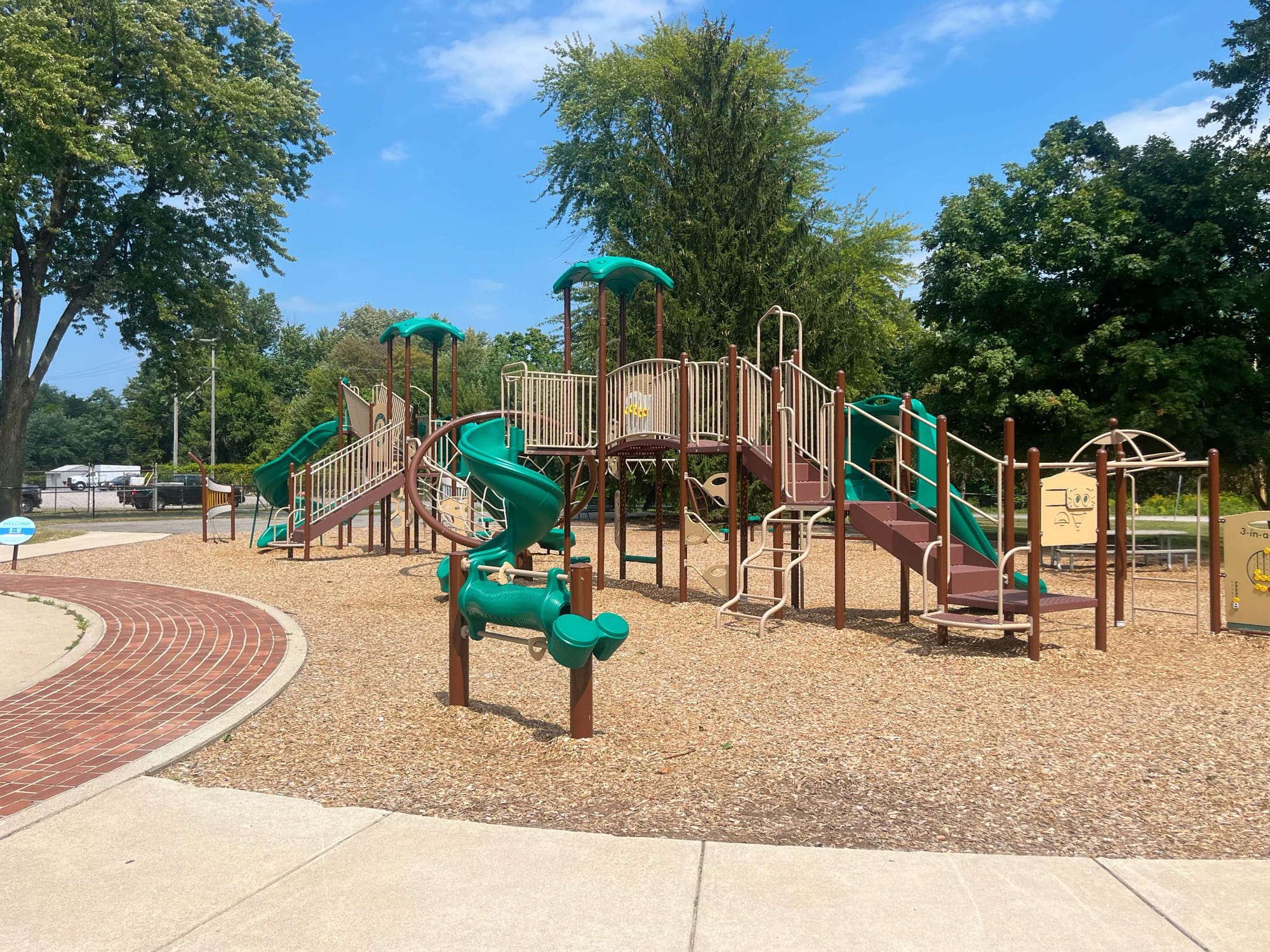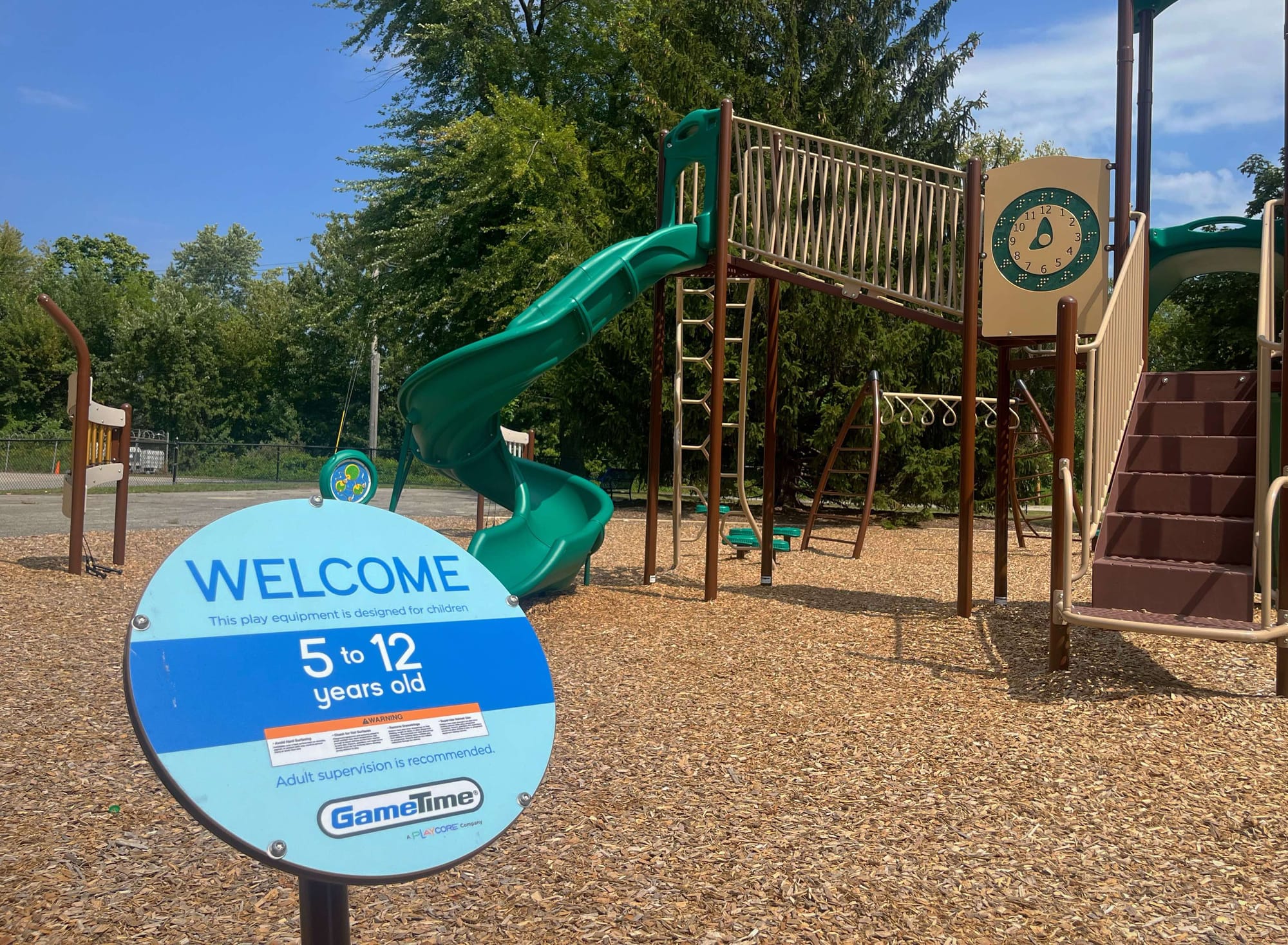Details on playground updates at 10 Fort Wayne Parks

If you’ve visited Fort Wayne parks this summer, you might have noticed new playground equipment.
Last year, the city received a more than $20 million tax surplus from the state, allowing the mayor and City Council to invest about $2 million in 10 parks, with $1.66 million specifically to upgrade playgrounds, which reached completion in July.
As Manager of Project Administration with Fort Wayne Parks and Recreation, Dave Weadock says the updates will have a “significant impact” on local parks and his department, making playgrounds more inclusive and refocusing resources away from maintaining older, outdated equipment in favor of creating more equitable play experiences across the city.
While playground updates are generally well-received, longtime park users in Fort Wayne might notice different types of equipment available as a result of these changes. We recently received a reader question, saying while they appreciate the improved accessibility, safety and lower maintenance of the new playgrounds, they're also sad to lose the unique wooden playground equipment at Lawton Park.
“It was in need of repair. But today, it’s all gone, replaced by playground equipment that can be found at any park or school around the city,” the reader says. “I also wonder: by replacing all these playgrounds at the same time, does it create a future issue with them needing to be upgraded at the same time however many years later?”
We sat down with Weadock to learn more and find out.

Give us a little background on you and your role at the Parks Department.
DW: I’m a registered landscape architect, and I’ve been in my current role since started I working for Parks about six years ago. Essentially, I manage any special projects that improve Fort Wayne’s parks system and require construction. We’re provided funding to do that from either taxpayer dollars, grants or trust money.
How many total playgrounds are in Fort Wayne parks, and how did you determine which ones would get updates this year?
DW: Fort Wayne has 89 parks and 57 playgrounds total. Some of the larger parks have multiple playgrounds. Within the Parks Department, we analyze playgrounds on a yearly basis, checking them for safety and where are they are within their lifecycle. Then we prioritize replacement for an entire playground based on all the information we gather.
The 10 playgrounds we ended up renovating this year were right at the top of our list of being ready for new installation. Some of those were anywhere from 20-25 years old, and some types of playground equipment just age faster than others, depending on frequency of use or location. For example, a playground in the sun may fade faster than one in a shaded area.
Here’s a quick breakdown of how the city distributed funding for our 10 playgrounds:
- Lawton Park – $245,000
- McMillen Park – $190,000
- Kettler Park – $180,000
- Foster Park – $200,000
- Northside Park – $175,000
- Tillman Park – $130,000
- Turpie Playlot – $120,000
- Kreager Park – $175,000
- Gren Park – $125,000
- Boone Park – $120,000
How did you go about making the playground updates?
DW: We issued a Request for Proposal (RFP) from vendors that supply playground equipment across the country, and we received nearly 60 proposals – anywhere from five to six per playground. We had previously established a budget for each playground based on its size, so we analyzed the vendor designs based on what best fit the space and budget. We ended up with six vendors to redesign our 10 playgrounds, so some of them did multiple sites.
What are some of biggest improvements?
DW: Most of the equipment at these 10 playgrounds was 20- to 25-years-old, so in terms of technology and trends with current playgrounds, the equipment and design were upgraded and modernized. We also wanted to have greater accessibility and inclusiveness for anybody who wants to play. Twenty years ago, accessible equipment was not nearly as available as it is today, so we made sure that all of the equipment at every playground had a high level of inclusiveness. As a result, there’s a lot of ground-mounted activities now. Some are music-oriented or have features where kids can use their fingers to move parts around and engage that way. This equipment also tends to be an area where kids can gather and play together, improving their dexterity, but also providing the socialization of playing with other kids.

Tell us more about the new equipment at Lawton Park specifically and why the older, perhaps more unique equipment was replaced.
DW: When it was originally installed, Lawton Park’s playground was very large – probably one of our largest playgrounds. It’s wooden, and the wooden parts stopped being made for its equipment after 2009. So here we are, 15 years later with a playground that’s completely outdated in terms of being able to replace parts, and unfortunately, we have to maintain it pretty extensively on a weekly basis because it’s made from wood, and it’s highly used.
With our newer playgrounds, we typically only have to maintain them about once a year. So, man hours were part of our decision to update the equipment and also trying to modify the playground according to what’s deemed safe and inclusive by today’s standards.
Wood playgrounds, in general, are not something you typically see anymore. In our environment, the material just wears out too quickly, and unfortunately, even if we did replace them with modern wood, wood products today aren’t what they were even 20- or 25-years ago.
There is some pretty substantial, high-dollar equipment that can be made out of a more durable wood product, but rarely to do you see new playgrounds made of the same type of wood that was used at Lawton.

Tell us about the vendor you chose to renovate Lawton Park and why?
DW: For Lawton Park, we selected Sinclair Recreation out of Holland, Michigan. They did three out of our 10 playgrounds, including Lawton, McMillen (recently finished) and Foster Park.
One of the things we liked about their designs was their unique approach to equipment with data. They consider themselves “play researchers” and partner with another company called PlayCore to analyze data for playgrounds and look more deeply into how their equipment is being used after it’s installed.
When you visit those playgrounds now, you might notice each playground has a QR code on signage that anyone can scan to see how much the equipment is being used and offer feedback. Parks is still working with Playcore and Sinclair to better understand their processes for collecting and utilizing that data.
Tell us about some of the other vendors chosen for different playgrounds.
DW: We tried to choose each vendor and playground based on how much value we’d get from the design. We wanted them to have different strengths and variety, so not every playground is going to function the same. A lot of playground equipment today is made from similar looking material, so I see why they might all start to look similar, but there actually is variety in how the equipment can be used.
In, Kettler Park, we chose Miracle Playgrounds because in many of their designs, they included a tower structure, which was impressive and unique.
Midstates Recreation did Boone and Northside Park, and they were very in tune with inclusiveness and accessibility. You might notice that Boone Park also received a full turf resurfacing. We got a grant for that from AWS Foundation. Unfortunately, we couldn’t do turf at all of our playgrounds due to the cost, which is about 10 times more expensive than what our other playgrounds have (an engineered wood fiber mulch). But we do love doing turf when we can.
Is there concern that because 10 playgrounds were updated this year, they might all need to be replaced at the same time in the future?
DW: It’s something we’ve thought about, but again, playground equipment ages differently, so I think there’s still going to be variation in when these playgrounds need to be updated in the future.
What public feedback have you received so far, and can readers offer more feedback?
DW: We’ve gotten a lot of positive comments so far. Some of us have been at the playgrounds when families have used them for the first time with their kids, and the kids are thrilled. I think people have been anxious see them to get upgraded. It’s taken longer than we wanted, partly due to weather and construction delays. But we finally have all 10 complete, and we’re thrilled about that.
We’d encourage any park users to provide feedback for what they like and what can be improved. As much as we try to accommodate and include things in playgrounds or any park facility, having feedback is vital for us to know what people want and what to improve. Feel free to email us on the Parks website.
What’s next for local parks and playgrounds?
DW: We’re getting ready to break ground on two more park redevelopments: One at Brewer Park, and one at Packard Park. Both will have new playgrounds next year, too. The one at Brewer will have a splash pad and will be done by PlayPros. The one at Packard is not yet planned. But stay tuned for updates!
